The Millau Viaduct (French: Viaduc de Millau) is a cable-stayed bridge that spans the gorge valley of the Tarn near Millau in Southern France.
In an Anglo-French partnership, it was designed by the French structural engineer Michel Virlogeux and English architect Norman Foster.
it is the tallest bridge in the world, having a structural height of 336.4 metres (1,104 ft).(as of 2020)
The Millau Viaduct is part of the A75–A71 autoroute axis from Paris to Béziers and Montpellier. The cost of construction was approximately € 394 million ($ 424 million).
It was built over three years, formally inaugurated on 14 December 2004, and opened to traffic two days later on 16 December. The bridge has been consistently ranked as one of the greatest engineering achievements of all time, and received the 2006 Outstanding Structure Award from the International Association for Bridge and Structural Engineering.
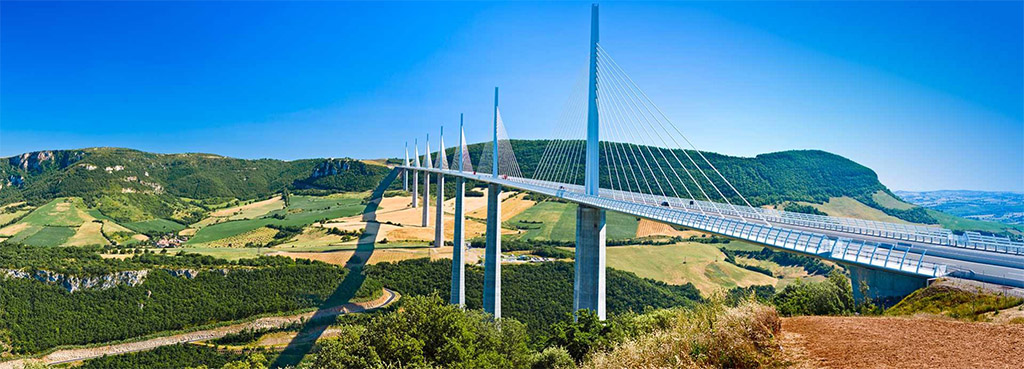
Construction
Two weeks after the laying of the first stone on December 14, 2001, the workers started digging the deep shafts. There were four shafts per pylon; 15 metres (49 ft) deep and 5 metres (16 ft) in diameter, assuring the stability of the pylons.
At the bottom of each pylon, a tread of 3–5 metres (10–16 ft) in thickness was installed to reinforce the effect of the deep shafts. The 2,000 cubic metres (2,600 cu yd) of concrete necessary for the treads was poured at the same time.
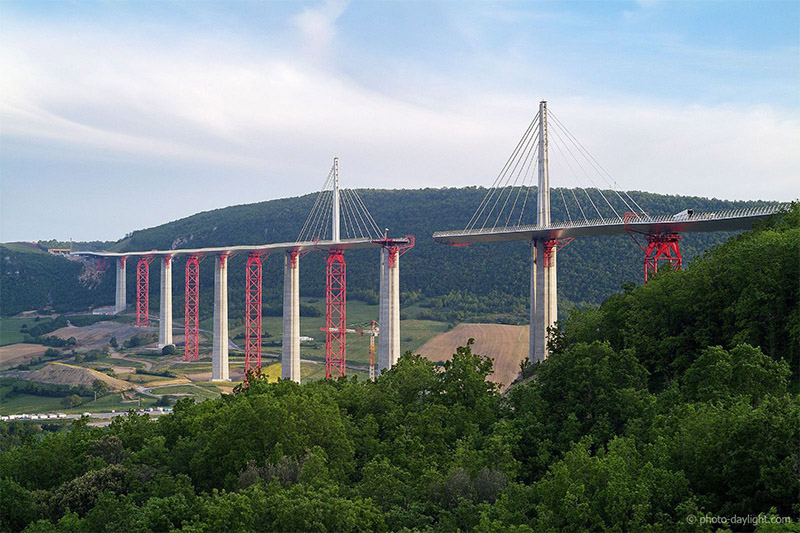
In March 2002, the pylons emerged from the ground. The speed of construction then rapidly increased. Every three days, each pylon increased in height by 4 metres (13 ft).
This performance was mainly due to sliding shuttering. Thanks to a system of shoe anchorages and fixed rails in the heart of the pylons, a new layer of concrete could be poured every 20 minutes.
The bridge road deck was constructed on land at the ends of the Viaduct, and rolled lengthwise from one pylon to the next, with eight temporary towers providing additional support. The movement was accomplished by a computer-controlled system of pairs of wedges under the deck.

The upper and lower wedges of each pair pointing in opposite directions. These were hydraulically operated, and moved repeatedly in the following sequence: the lower wedge slides under the upper wedge, raising it to the roadway above, and then forcing the upper wedge still higher to lift the roadway. Both wedges move forward together, advancing the roadway a short distance. The lower wedge retracts from under the upper wedge, lowering the roadway and allowing the upper wedge to drop away from the roadway; the lower wedge then moves back all the way to its starting position.
There is now a linear distance between the two wedges equal to the distance forward the roadway has just moved. The upper wedge moves backward, placing it further back along the roadway, adjacent to the front tip of the lower wedge and ready to repeat the cycle and advance the roadway by another increment. It worked at 600 millimetres (24 in) per cycle which was roughly four minutes long.
The mast pieces were driven over the new road deck lying down horizontally. The pieces were joined to form the one complete mast, still lying horizontally. The mast was then tilted upwards, as one piece, at one time in a tricky operation.
In this way, each mast was erected on top of the corresponding concrete pylon. The stays connecting the masts and the deck were then installed, and the bridge was tensioned overall, and weight tested. After this, the temporary pylons could be removed.
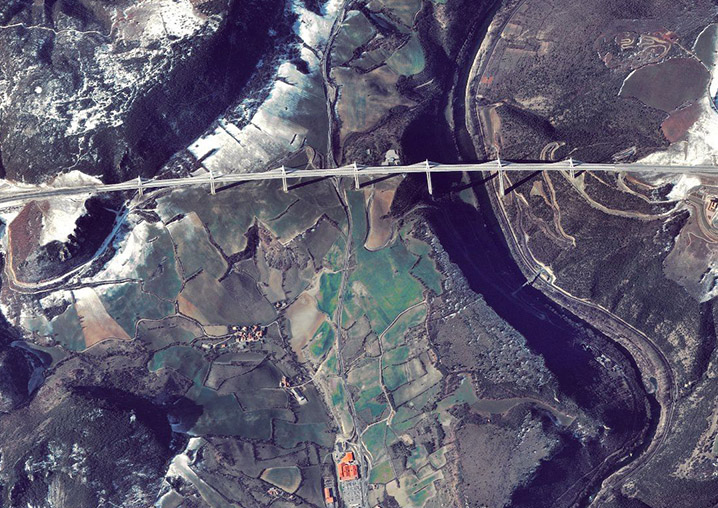
Timeline
- 16 October 2001: work begins
- 14 December 2001: laying of the first stone
- January 2002: laying pier foundations
- March 2002: start of work on the pier support C8
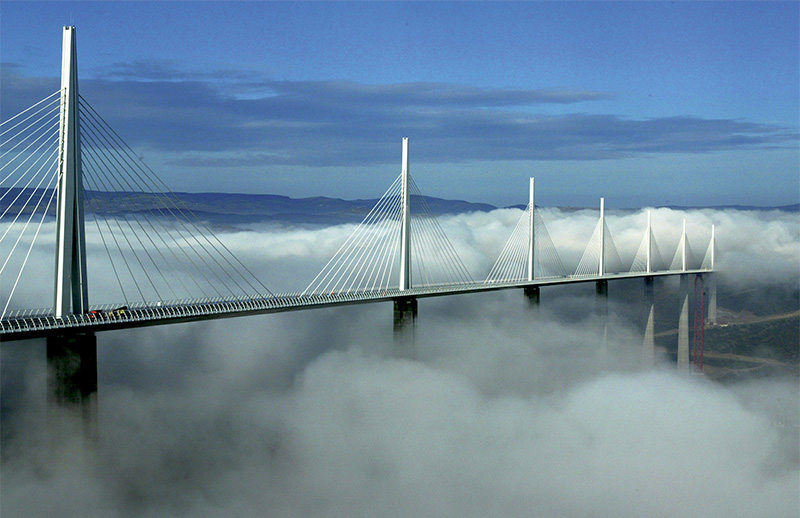
- June 2002: support C8 completed, start of work on piers
- July 2002: start of work on the foundations of temporary, height adjustable roadway supports
- August 2002: start of work on pier support C0
- September 2002: assembly of roadway begins
- November 2002: first piers complete
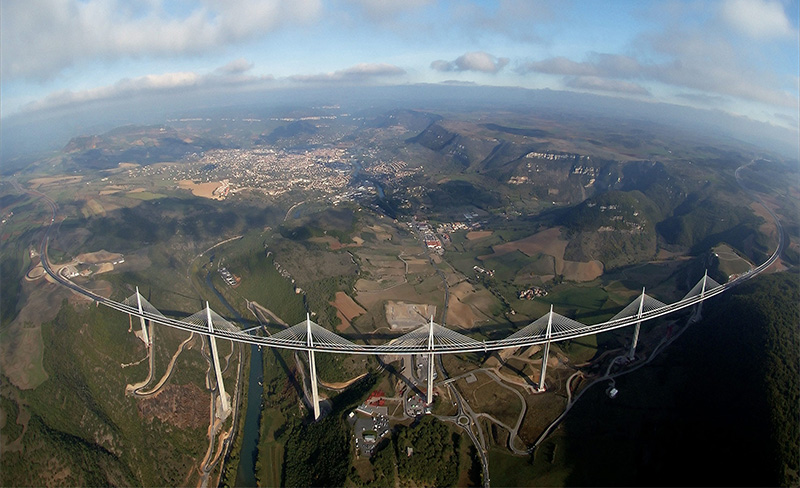
- 25–26 February 2003: laying of first pieces of roadway
- November 2003: completion of the last piers (piers P2 at 245 metres (804 ft) and P3 at 221 metres (725 ft) are the highest piers in the world)
- 28 May 2004: the pieces of roadway are several centimetres apart, their juncture to be accomplished within two weeks
- 2nd half of 2004: installation of the pylons and shrouds, removal of the temporary roadway supports
- 14 December 2004: official inauguration
- 16 December 2004: opening of the viaduct, ahead of schedule
- 10 January 2005: initial planned opening date
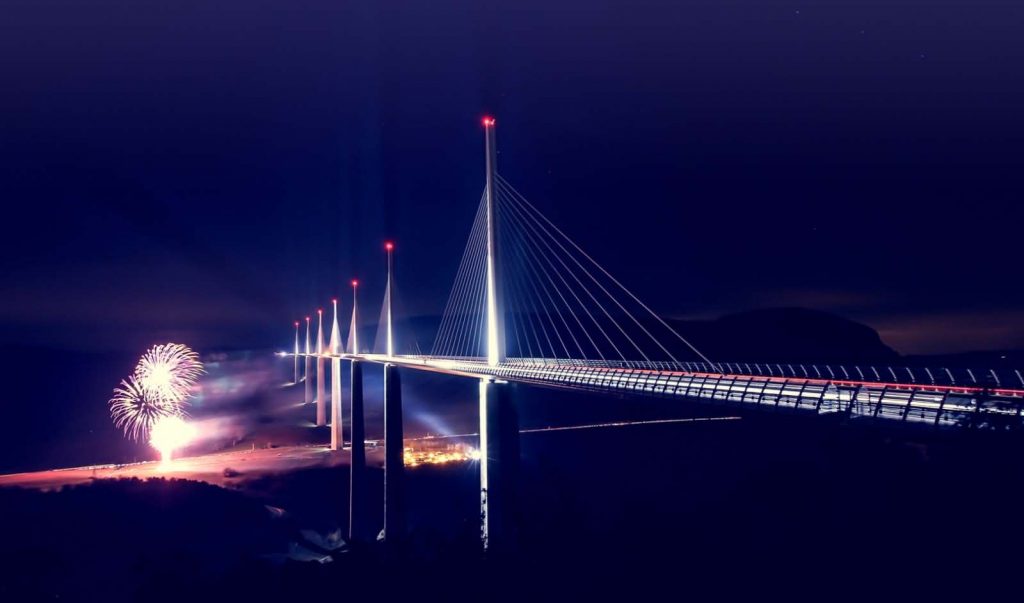
Millau Viaduct Data
- Country
- France
- Location
- Millau-Creissels, Aveyron, France
- Official name
- Viaduc de Millau
- Cost
- €394 million (US$424 million)
- Status
- In use
- Constructed by
- Compagnie Eiffage du Viaduc de Millau
- Design life
- 120 years
- Began
- Oct-16, 2001
- Opening date
- Dec-16, 2004
- Total Duration
- 3 years
- Height
- 336 m (1,104 ft)
- Length
- 2,460 m(8,071 ft)
- Width
- 32.1 m (105 ft)
- Deck height
- 270 m(886 ft)
- Longest span
- 342 m(1,122 ft)
- Design type
- Multiple-span cable-stayed bridge
- Bridge type
- Cross River Bridge
- River
- Tarn River
- Road scale
- 4 lanes
- Toll
- from € 8.30
View Millau Viaduct on Google Satellite Map
Google satellite maps allow you to see building details more clearly, including natural landscapes such as mountains, rivers, deserts, sea and man-made engineering buildings.
If you are very interested in this engineering building, it is a good idea to click below Google Map icon. We will help you jump to the corresponding location of this building or engineering on Google satellite map.






























































